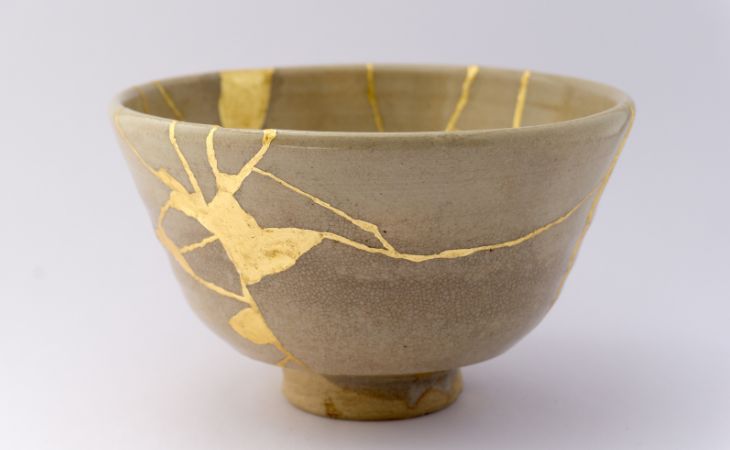In the Far East, there are various philosophies and approaches to life, all aimed at helping the soul cope better with reality, which isn’t always easy, calm, or pleasant. In today’s world, where stress is almost a constant factor and the pace of life is faster than ever, any help in relieving stress levels or slowing down is welcome, and the Japanese Wabi-Sabi approach can provide exactly that. In essence, the Wabi-Sabi approach asks one thing from us – to find beauty in imperfection and accept the natural cycle of life, which itself is imperfect. It’s as simple as it sounds, and now you will discover 5 lessons this life philosophy will teach you if you embrace it.
First of all – how do you incorporate Wabi-Sabi into your life?
The Wabi-Sabi philosophy has two main themes:
Wabi: Recognizing the beauty in humility and simplicity. The Wabi aspect invites us to keep an open heart and disconnect from showiness and materialism so we can experience spiritual richness instead.
Sabi: The passage of time and the way everything grows, ages, and decays. The Sabi aspect suggests that in each such stage there is its own beauty, which sometimes hides beneath the surface and we may not notice if we don’t try.
Together, these two parts make up a complete life philosophy of appreciating the simple things and accepting the changes that occur in life. If you feel this is somewhat lacking in your life, the following 5 lessons are definitely for you, and they will show you how to adopt such an approach and what it can truly do for you.

1. Through acceptance, you achieve freedom; by accepting, you can grow
The acceptance Wabi-Sabi speaks of can be summed up in one Japanese word: “Okettamo,” which means “I accept with humility and an open heart.” Here’s how it works:
- You’re about to lose your job – Okettamo
- The weather unexpectedly changed and rain canceled an event you were looking forward to – Okettamo
- You were in an accident, broke your leg, and will be in a cast for a few weeks – Okettamo
This is complete acceptance of reality, without trying to resist things we cannot influence. The sooner you accept the bad things (and the good) that life brings, the easier it will be for you. This way you will find true freedom from suffering, and you will be able to grow and develop as a person.
All this connects to the idea of Wabi-Sabi because it teaches us how to be at peace with imperfection – to accept it instead of trying to fight it; to find peace here and now instead of clinging to what we think will make us peaceful, but is unattainable. The more you struggle, the more you will continue to suffer, so it’s recommended to let go and free yourself from suffering. It’s not the same as giving up, but more like surrendering to gravity, which you already do every day without a fight. So when something bad happens, remember the word – Okettamo.

2. Everything in life is in an imperfect state
Everything in our reality changes, and nothing stays complete, so we must give up the idea of “perfection,” because it’s not achievable. If you find it hard to do so, the Wabi-Sabi approach suggests changing what you consider beautiful and good and attributing the opposite meaning to the word “perfect” – everything flawed, inferior, broken, and wrong. These words sound negative, but think about it – does the pursuit of perfection bring you to a positive place?
Sometimes it’s not even our own opinion that tells us what’s beautiful and good, but what society has taught us, and so we find ourselves chasing after ideas we might not truly agree with deep down, causing us to feel less worthy of them or diminishing our motivation to achieve them. So remind yourself that perfection doesn’t exist because imperfection is the natural state of life, and everything is “complete” exactly as it is. Remind yourself that imperfection is not a compromise, but simply the truth as it is.
But it doesn’t end here because Wabi-Sabi says something else important: don’t strive for perfection, but for excellence. In other words, do the best you can. Whether it’s your relationship with your partner, at work, or in school, try your best to succeed and do what is right; don’t strive for perfection, but for success. Remember, no palm tree has a perfect shape, yet we are still amazed by the beauty and grandeur of each one. Their imperfection is what makes them unique and impressive.

3. Beauty hides beneath the surface of what seems broken
When a bowl or cup breaks, we don’t think twice and immediately throw them in the trash, but those familiar with Wabi-Sabi know that the breakage isn’t the end of the vessel, but only a new beginning. The Wabi-Sabi approach helped create a type of art called “Kintsugi,” which means “golden joinery.” In this technique, broken pottery is repaired using resin and gold, silver, or platinum powder, not only restoring the vessel’s shape but also giving it beautiful and unique “scars.” This makes the vessel’s imperfection eternal, yet somehow it’s more beautiful and special than it was as a whole piece.
This art technique reminds us that even in what is broken and scarred, there is beauty, and it emphasizes how determination and wisdom can help us come to terms with the changes that time brings in life. Why hide the imperfections? You can highlight them with gold and celebrate them. We too feel “broken” at times, whether physically or emotionally. But we shouldn’t hide our scars; we should let them shine. Such an approach reminds us to forgive ourselves for our mistakes, accept them, and even see the wrinkles that appear over the years on our faces as a sign of a life full of laughter and smiles.

4. Slowly and simply – only this way can you truly enjoy life
Sometimes it’s hard to see the beauty that hides beneath the surface, but the trick is to slow down and try to maintain an approach where simplicity isn’t necessarily a bad thing. Both of these have long-term beneficial effects; slowing down allows you to become more aware and sharpens your self-awareness. It encourages you to ask yourself important questions, and naturally, it helps you live in the present instead of trying to live in the future. When we rush too much, we burn out, and only too late do we realize our mistakes. On the other hand, if you slow down, you can keep your mind and spirit sharper and calmer, analyzing and solving problems before they arise or worsen.
Simplicity, on the other hand, is the cure for those who feel their lives are too complicated. At some point, we all want to change something in our lives, and usually, the question that arises in our minds is “what should I add?” But sometimes the question should be “what should I remove?” For example, if you’re moving to a new home, don’t just think about what you need to buy for it, but also what you can get rid of that you no longer need. You should do this occasionally in your soul too, getting rid of certain habits so you can make room for new habits, personal development, and change. Let go of what no longer serves you and create space for what does.

5. To be happy is to be content with where you are and what you already have
Everyone is constantly searching for happiness, but this only turns us into victims of our own pursuit. You don’t need to chase after the next success or the fulfillment of your biggest dream to be happy because that’s not the way to happiness. Yes, it will bring you achievements you can be proud of and may even improve your life in some way, but if you hope this will bring happiness to your soul, you will only be left with a feeling of emptiness. There’s an illusion that once we reach our destination, everything will fall into place, and we will be happy forever, but that’s not what happens. This approach is like playing tag with a ghost that you can never truly catch.
This constant chase for happiness blinds us to what it truly is – just another emotion among the many we experience. Since our emotions are constantly changing, happiness is not something that remains permanent; it makes room for other emotions and returns after they pass. This is where the Wabi-Sabi approach comes in, teaching us to be content with what we have and what is happening to us, including the happy and joyful moments, as well as the sad or frustrating ones.
According to Wabi-Sabi, and other philosophies from the Far East, the source of our unhappiness is dissatisfaction. As long as we want more or different things, we won’t be happy, and to achieve true happiness, we need to say thank you for what we have right now. Of course, it’s fine to expect good things to happen in the future and wish for them, but don’t fixate on them and wait in misery for their arrival. In the meantime, say thank you for all that is already here and good. This brings us back in a circle to the first point you learned – acceptance.

A few words in conclusion
Wabi-Sabi is an approach that invites us to accept what happens to us, understand that not everything needs to be perfect, learn how to see the beauty in imperfection, slow down, enjoy simplicity, and find happiness in all these things and what we already have in life. In simple terms, Wabi-Sabi gives you permission to be who you are. It encourages us to do our best, but not to exhaust ourselves by chasing an unattainable goal of perfection. It gently signals us to relax, slow down, and enjoy life, showing us that we can find beauty in the most unexpected places. It’s a very healthy approach to living a good life.






